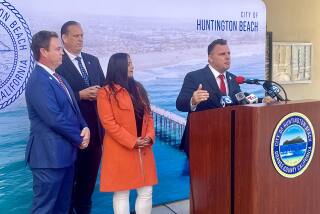Huntington Beach OKs Public Golf Course Plan
- Share via
Despite strong objections from equestrians, runners and environmentalists, Huntington Beach is moving forward with plans to build an 18-hole public golf course on an undeveloped tract of land in the city’s sprawling Central Park.
Construction of the golf course, to be built and operated under a 40-year contract with the American Golf Corp., is tentatively scheduled to begin next June. The target date for opening is January, 1992.
The Huntington Beach City Council approved the golf course plan by a 5-2 vote after a heated public hearing Tuesday night attended by about 200 people.
According to a report by an ad hoc committee set up to study the proposal, the course will bring in a minimum of $200,000 a year to city coffers over the first five years, and annual revenue should jump to more than $500,000 after 20 years. The committee said the golf course will attractively develop an area that is “currently an eyesore.”
At the meeting, however, more than 30 residents spoke out against the proposal in a 3 1/2-hour debate focusing on its environmental and aesthetic ramifications on Central Park, a 380-acre tract on both sides of Golden West Street at Talbert Avenue.
Some speakers expressed fear that the golf course would further encroach on the park’s shrinking open space and force out joggers, horseback riders, mountain bike enthusiasts and school cross-country teams in favor of golfers. Opponents said golfers account for only 8% of the city’s population.
Others warned that fertilizers and pesticides used to maintain the course would leach through the soil and contaminate ground-water supplies and nearby Lake Huntington. Some questioned whether the area’s diminishing water supply could even meet the maintenance demands of more than 90 acres of fairways and greens.
Mayor Wes Bannister, however, replied that even if the city does not build the golf course it is still liable to maintain and clean up the area, which would require the use of city water and cost taxpayers an estimated $5 million to remove contaminated soil, abandoned oil derricks and garbage.
Moreover, Bannister said that even with the golf course the city would still possess more than 1,800 acres of open space in the form of wetlands and parks, plus nine miles of public beaches.
Some speakers demanded that the city honor three city surveys that they claim overwhelmingly show public opposition to the golf course.
Bannister countered that the surveys were either dated, incomplete or poorly worded and entirely unrelated to the golf course. He also noted that even though the surveys made no mention about a possible public golf course, many of the respondents wrote in that they would like to see the city build one.
About 25 people spoke in favor of the proposal, saying that the only other such public facility, Meadowlark Golf Course, is so overcrowded that on busy days a four-hour wait is not unusual.
The proposal was passed with amendments requiring golf course revenues to be used to repay any related city costs and fund future park acquisitions. The council also amended the proposal to include civic associations and interest groups in future negotiations regarding the course.
Voting to move ahead with the golf course were Bannister and council members John Erskine, Don MacAllister, Tom Mays and Jim Silva. Casting dissenting votes were council members Grace Winchell and Peter M. Green.
More to Read
Sign up for Essential California
The most important California stories and recommendations in your inbox every morning.
You may occasionally receive promotional content from the Los Angeles Times.










